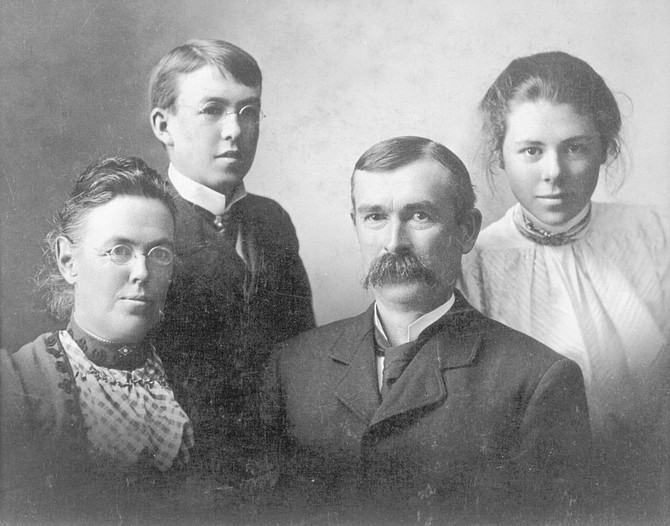 Facebook
Facebook
 X
X
 Instagram
Instagram
 TikTok
TikTok
 Youtube
Youtube

“CHARLOTTE BAKER: FIRST WOMAN PHYSICIAN AND COMMUNITY LEADER IN TURN OF 19TH-CENTURY SAN DIEGO”
ALMA KATHRYN ROBENS, MASTER’S THESIS,
SDSU, 1992
Charlotte Baker and her husband Fred came to San Diego in January 1888. Both were physicians who earned degrees at the University of Michigan. The first woman doctor in San Diego, Charlotte delivered over 1000 babies and boasted she “never lost a mother."
The Bakers had an office/home at Seventh, between F and G Streets. Later they built a two-story house in Point Loma on nine-tenths of an acre. It was the only house in Point Loma for several years. They sailed to work downtown, making the trip in 20 minutes in good weather and up to five hours in bad.
Their regular office hours were between eleven and three o’clock. They made exceptions, though, because most patients wouldn't miss a day's work to see a doctor, so the Bakers often worked after dark and on Sundays.
Charlotte Baker's first presentation to the local medical society was on the use of hypnotism as a treatment for pain.
In a lifetime of service to the community, Fred Baker co-founded the San Diego Zoo and Scripps Institution. Charlotte “was always in the frontline trenches for justice and right."
She co-founded the YWCA in San Diego, though it wasn't called that in 1907. In 1933, Baker wrote, “as usual, Adam's claims came first and we women were called the YMCA Auxiliary.” She had gospel singers give a performance in 1907 “to try to arouse the needs of Eve as well as Adam."
Baker advocated “municipal housekeeping." She helped form clubs and urged women to take an active part in protecting other women's lives. Robens writes, “a short, stocky New Englander, [Baker] was brusque, direct, and assertive. She worked professionally, raised two children and a foster son.... She performed active service in the community, even if she tarnished the men's image of the traditional compliant female."
She helped close the Stingaree, San Diego's red-light district. She led the Women's Suffrage Campaign of 1911. She even received a death threat. The note read, “have just received orders to exterminate you at once (Dynamite will be used)."
Robens sums up Baker's achievement: “Her political activities spanned 20 years. She was 56 when she led the suffrage campaign and 76 when she left her position on the Civil Service Commission. During this period the country went to war, San Diego suffered from a worldwide influenza epidemic, experienced a catastrophic flood, saw the ratification of the 19th Amendment, witnessed the prohibition of liquor, and adjusted to changes in local government and politics. It is within this context that Baker worked toward her goal...of public support for women."
Baker died October 31,1937. She was 82. Her motto: “If I had my life to live over again, I would not alter my course unless to fight harder."
MASTER'S THESIS EXCERPTS:


“CHARLOTTE BAKER: FIRST WOMAN PHYSICIAN AND COMMUNITY LEADER IN TURN OF 19TH-CENTURY SAN DIEGO”
ALMA KATHRYN ROBENS, MASTER’S THESIS,
SDSU, 1992
Charlotte Baker and her husband Fred came to San Diego in January 1888. Both were physicians who earned degrees at the University of Michigan. The first woman doctor in San Diego, Charlotte delivered over 1000 babies and boasted she “never lost a mother."
The Bakers had an office/home at Seventh, between F and G Streets. Later they built a two-story house in Point Loma on nine-tenths of an acre. It was the only house in Point Loma for several years. They sailed to work downtown, making the trip in 20 minutes in good weather and up to five hours in bad.
Their regular office hours were between eleven and three o’clock. They made exceptions, though, because most patients wouldn't miss a day's work to see a doctor, so the Bakers often worked after dark and on Sundays.
Charlotte Baker's first presentation to the local medical society was on the use of hypnotism as a treatment for pain.
In a lifetime of service to the community, Fred Baker co-founded the San Diego Zoo and Scripps Institution. Charlotte “was always in the frontline trenches for justice and right."
She co-founded the YWCA in San Diego, though it wasn't called that in 1907. In 1933, Baker wrote, “as usual, Adam's claims came first and we women were called the YMCA Auxiliary.” She had gospel singers give a performance in 1907 “to try to arouse the needs of Eve as well as Adam."
Baker advocated “municipal housekeeping." She helped form clubs and urged women to take an active part in protecting other women's lives. Robens writes, “a short, stocky New Englander, [Baker] was brusque, direct, and assertive. She worked professionally, raised two children and a foster son.... She performed active service in the community, even if she tarnished the men's image of the traditional compliant female."
She helped close the Stingaree, San Diego's red-light district. She led the Women's Suffrage Campaign of 1911. She even received a death threat. The note read, “have just received orders to exterminate you at once (Dynamite will be used)."
Robens sums up Baker's achievement: “Her political activities spanned 20 years. She was 56 when she led the suffrage campaign and 76 when she left her position on the Civil Service Commission. During this period the country went to war, San Diego suffered from a worldwide influenza epidemic, experienced a catastrophic flood, saw the ratification of the 19th Amendment, witnessed the prohibition of liquor, and adjusted to changes in local government and politics. It is within this context that Baker worked toward her goal...of public support for women."
Baker died October 31,1937. She was 82. Her motto: “If I had my life to live over again, I would not alter my course unless to fight harder."
MASTER'S THESIS EXCERPTS: